SINGAPORE - The Civil Aviation Authority of Singapore's (CAAS) net surplus for the year ended March 31 strengthened to $78.05 million from $76.44 million a year ago.
The aviation regulator's surplus was partly boosted by lower contributions to a government consolidated fund. For the year under review, the contributions were $15.23 million, versus $16.48 million a year ago.
Income for the financial year rose to $469 million from $447.17 million, thanks to higher income from aviation levies, and from fees for airport and related services. However, expenditure also rose sharply during the financial year, to $461.68 million from $432.31 million, partly owing to increased salaries, wages and staff benefits, and higher spending on the maintenance of buildings and equipment.
Non-operating income rose to $17.96 million from $16.2 million, while the share of results of joint ventures and associates totalled $3.78 million, compared to losses of $2.2 million a year ago.
Surplus for the year before government grants worked out to $29.09 million, versus $28.87 million previously.
Government grants came to $64.19 million, close to the $64.05 million given out a year ago.
In the annual report, CAAS's then chairman Lee Hsien Yang and director-general Kevin Shum highlighted that the number of air traffic movements in the Singapore Flight Information Region rose by 6.6 per cent in 2017.
They said: "With robust air traffic growth, air traffic management (ATM) is becoming more complex. This is why we are pushing ahead to strengthen our ATM core capabilities, tapping advancements in technology, and forging partnerships with established global players to conduct research and development on new solutions to optimise our use of airspace, create capacity and ensure the safety of passengers."
In addition, the CAAS has increased the headcount of air traffic control officers, air traffic control support officers, engineers and technical support officers by 5 per cent.
They also highlighted that over the last year, the air transport sector's real value-add increased by 5 per cent, higher than the national average of 3.6 per cent, with productivity growing by 5.7 per cent. Meanwhile, the aviation workforce also expanded by 2 per cent.

